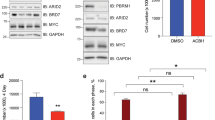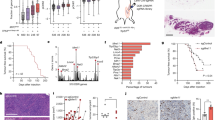Abstract
There is a gap between the initial formation of cells carrying radiation-induced genetic damage and their contribution to cancer development. Herein, we reveal a previously uncharacterized gene FATS through a genome-wide approach and demonstrate its essential role in regulating the abundance of p21 in surveillance of genome integrity. A large exon coding the NH2-terminal domain of FATS, deleted in spontaneous mouse lymphomas, is much more frequently deleted in radiation-induced mouse lymphomas. Its human counterpart is a fragile site gene at a previously identified loss of heterozygosity site. FATS is essential for maintaining steady-state level of p21 protein and sustaining DNA damage checkpoint. Furthermore, the NH2-terminal FATS physically interacts with histone deacetylase 1 (HDAC1) to enhance the acetylation of endogenous p21, leading to the stabilization of p21. Our results reveal a molecular linkage between p21 abundance and radiation-induced carcinogenesis.
This is a preview of subscription content, access via your institution
Access options
Subscribe to this journal
Receive 50 print issues and online access
$259.00 per year
only $5.18 per issue
Buy this article
- Purchase on Springer Link
- Instant access to full article PDF
Prices may be subject to local taxes which are calculated during checkout








Similar content being viewed by others
Accession codes
References
Abbas T, Dutta A . (2009). p21 in cancer: intricate networks and multiple activities. Nat Rev Cancer 9: 400–414.
Barboza JA, Liu G, Ju Z, El-Naggar AK, Lozano G . (2006). p21 delays tumor onset by preservation of chromosomal stability. Proc Natl Acad Sci USA 103: 19842–19847.
Bendiennat M, Boulaire J, Jascur T, Brickner H, Barbier V, Sarasin A et al. (2003). UV irradiation triggers ubiquitin-dependent degradation of p21(WAF1) to promoter DNA repair. Cell 114: 599–610.
Bichara M, Wagner J, Lambert IB . (2006). Mechanisms of tandem repeat instability in bacteria. Mut Res 598: 144–163.
Bloom J, Amador V, Bartolini F, DeMartino G, Pagano M . (2003). Proteasome-mediated degradation of p21via N-terminal ubiquitinylation. Cell 115: 71–82.
Brenner DJ, Doll R, Goodhead DT, Hall EJ, Land CE, Little JB et al. (2003). Cancer risks attributable to low doses of ionizing radiation: assessing what we really know. Proc Natl Acad Sci USA 100: 13761–13766.
Brugarolas J, Chandrasekaran C, Gordon JI, Beach D, Jacks T, Hannon GJ . (1995). Radiation-induced cell cycle arrest compromised by p21 deficiency. Nature 377: 552–557.
Bunz F, Dutriaux A, Lengauer C, Waldman T, Zhou S, Brown JP et al. (1998). Requirement for p53 and p21 to sustain G2 arrest after DNA damage. Science 282: 1497–1501.
Buttel I, Fechter A, Schwab M . (2004). Common fragile sites and cancer: targeted cloning by insertional mutagenesis. Ann NY Acad Sci 1028: 14–27.
Cai WW, Mao JH, Chow CW, Damani S, Balmain A, Bradley A . (2002). Genome-wide detection of chromosomal imbalances in tumors using BAC microarrays. Nat Biotechnol 20: 393–396.
Casper AM, Nghiem P, Arlt MF, Glover TW . (2002). ATR regulates fragile site stability. Cell 111: 779–789.
Cen B, Deguchi A, Weinstein IB . (2008). Activation of protein kinase G increases the expression of p21CIP1, p27KIP1, and histidine triad protein 1 through Sp1. Cancer Res 68: 5355–5362.
Chen X, Chi Y, Bloecher A, Aebersold R, Clurman BE, Roberts JM . (2004). N-acetylation and ubiquitin-independent proteasomal degradation of p21(Cip1). Mol Cell 16: 839–847.
Chen X, Barton LF, Chi Y, Clurman BE, Roberts JM . (2007). Ubiquitin-independent degradation of cell-cycle inhibitos by the REGγ proteasome. Mol Cell 26: 843–852.
Coulombe P, Rodier G, Bonneil E, Thibault P, Meloche S . (2004). N-terminal ubiquitination of extracellular signal-regulated kinase 3 and p21 directs their degradation by the proteasome. Mol Cell Biol 24: 6140–6150.
Deng C, Zhang P, Harper JW, Elledge SJ, Leder P . (1995). Mice lacking p21CIP1/WAF1 undergo normal development, but are defective in G1 checkpoint control. Cell 82: 675–684.
DiTullio Jr RA, Mochan TA, Venere M, Bartkova J, Sehested M, Bartek J et al. (2002). 53BP1 functions in an ATM-dependent checkpoint pathway that is constitutively activated in human cancer. Nat Cell Biol 4: 998–1002.
Dokmanovic M, Clarke C, Marks PA . (2007). Histone deacetylase inhibitors: overview and perspectives. Mol Cancer Res 5: 981–989.
Durkin SG, Glover TW . (2007). Chromosome fragile sites. Annu Rev Genet 41: 169–192.
Efeyan A, Collado M, Velasco-Miguel S, Serrano M . (2007). Genetic dissection of the role of p21Cip1/Waf1 in p53-mediated tumor suppression. Oncogene 26: 1645–1649.
Glover TW, Arlt MF, Casper AM, Durkin SG . (2005). Mechanisms of common fragile site instability. Hum Mol Genet 14: R197–R205.
Holm LE . (1990). Cancer occurring after radiotherapy and chemotherapy. Int J Radiat Oncol Biol Phy 19: 1303–1308.
Hoppe-Seyler F, Butz K . (1993). Repression of endogenous p53 transactivation function in HeLa cervical carcinoma cells by human papillomavirus type 16 E6, human mdm-2, and mutant p53. J Virol 67: 3111–3117.
Johnstone RW . (2002). Histone-deacetylase inhibitors: novel drugs for the treatment of cancer. Nat Rev Drug Discov 1: 287–299.
Kastan MB, Bartek J . (2004). Cell-cycle checkpoints and cancer. Nature 432: 316–323.
Kemp CJ, Wheldon T, Balmain A . (1994). p53-deficient mice are extremely susceptible to radiation-induced tumorigenesis. Nat Genet 8: 66–69.
Kim GD, Choi YH, Dimtchev A, Jeong SJ, Dritschilo A, Jung M . (1999). Sensing of ionizing radiation-induced DNA damage by ATM through interaction with histone deacetylase. J Biol Chem 274: 31127–31130.
Lagger G, O'Carroll D, Rembold M, Khier H, Tischler J, Weitzer G et al. (2002). Essential function of histone deacetylase 1 in proliferation control and CDK inhibitor repression. EMBO J 21: 2672–2681.
Li X, Amazit L, Long W, Lonard DM, Monaco JJ, O'Malley BW . (2007). Ubiquitin- and ATP-independent proteolytic turnover of p21 by the REGγ-proteasome pathway. Mol Cell 26: 831–842.
Li Z, Day CP, Yang JY, Tsai WB, Lozano G, Shih HM et al. (2004). Adenoviral E1A targets Mdm4 to stabilize tumor suppressor p53. Cancer Res 64: 9080–9085.
Liehr T, Heller A, Starke H, Claussen U . (2002). FISH banding methods: applications in research and diagnosis. Expert Rev Mol Diagn 2: 217–225.
Lin RJ, Nagy L, Inoue S, Shao W, Miller WH, Evans RM . (1998). Role of the histone deacetylase complex in acute promyelocytic leukaemia. Nature 391: 811–814.
Macleod KF, Sherry N, Hannon G, Beach D, Tokino T, Kinzler K et al. (1995). P 53-dependent and independent expression of p21 during cell growth, differentiation, and DNA damage. Genes Dev 9: 935–944.
Magrath IT . (1997). The treatment of pediatric lymphomas: paradigms to plagiarize? Ann Oncol 8: 7–14.
Maier D, Comparone D, Taylor E, Zhang Z, Gratzl O, van Meir EG et al. (1997). New deletion in low-grade oligodendroglioma at the glioblastoma suppressor locus on chromosome 10q25-26. Oncogene 15: 997–1000.
Mangelsdorf M, Ried K, Woollatt E, Dayan S, Eyre H, Finnis M et al. (2000). Chromosomal fragile site FRA16D and DNA instability in cancer. Cancer Res 60: 1683–1689.
Mao JH, Li J, Jiang T, Li Q, Wu D, Perez-Losada J et al. (2005). Genomic instability in radiation-induced mouse lymphoma from p53 heterozygous mice. Oncogene 24: 7924–7934.
Martin-Caballero J, Flores JM, Garcia-Palencia P, Serrano M . (2001). Tumor susceptibility of p21(Waf1/Cip1)-deficient mice. Cancer Res 61: 6234–6238.
Maser RS, DePinho RA . (2002). Connecting chromosomes, crisis, and cancer. Science 297: 565–569.
Nagase S, Yamakawa H, Sato S, Yajima A, Horii A . (1997). Identification of a 790-kilobase region of common allelic loss in chromosome 10q25-q26 in human endometrial cancer. Cancer Res 57: 1630–1633.
Ohi R, Gould KL . (1999). Regulating the onset of mitosis. Curr Opin Cell Biol 11: 267–273.
Pagano M, Tam SW, Theodoras AM, Beer-Romero P, Del Sal G, Chau V et al. (1995). Role of the ubiquitin-proteasome pathway in regulating abundance of the cyclin-dependent kinase inhibitor p27. Science 269: 682–685.
Pearson CE, edamura KN, Cleary JD . (2005). Repeat instability: mechanisms of dynamic mutations. Nat Rev Genet 6: 729–742.
Rouse J, Jackson SP . (2002). Interfaces between the detection, signaling, and repair of DNA damage. Science 297: 547–551.
Schellong G . (1998). Pediatric Hodgkin's disease: treatment in the late 1990s. Ann Oncol 9: S115–S119.
Sherr CJ, Roberts TM . (1999). CDK inhibitors: positive and negative regulators of G1-phase progression. Genes Dev 13: 1501–1512.
Shiloh Y . (2003). ATM and related protein kinase: safeguarding genome integrity. Nat Rev Cancer 3: 155–168.
Schwartz M, Zlotorynski E, Kerem B . (2006). The molecular basis of common and rare fragile sites. Cancer Lett 232: 13–26.
Sheaff RJ, Singer JD, Swanger J, Smitherman M, Roberts JM, Clurman BE . (2000). Proteasomal turnover of p21Cip1 does not require p21Cip1 ubiquitination. Mol Cell 5: 403–410.
Touitou R, Richardson J, Bose S, Nakanishi M, Rivett J, Allday MJ . (2001). A degradation signal located in the C-terminus of p21WAF1/CIP1 is a binding site for the C8 alpha-subunit of the 20S proteasome. EMBO J 20: 2367–2375.
Van Gent DC, Hoeijmakers JH, Kanaar R . (2001). Chromosomal stability and the DNA double-stranded break connection. Nat Rev Genet 2: 196–206.
Varshavsky A, Turner G, Du F, Xie Y . (2000). Felix HoppeSeyler Lecture 2000. The ubiquitin system and the N-end rule pathway. Biol Chem 381: 779–789.
Wei Q, Miskimins WK, Miskimins R . (2003). The Sp1 family of transcription factor is involved in p27(Kip1)-mediated activation of myelin basic protein gene expression. Mol Cell Biol 23: 4035–4045.
Winter ZE, Leek RD, Bradburn MJ, Norbury CJ, Harris AL . (2003). Cytoplasmic p21WAF1/CIP1 expression is correlated with HER-2/neu in breast cancer and is an independent predictor of prognosis. Breast Cancer Res 5: R242–R249.
Xia W, Chen JS, Zhou X, Sun PR, Lee DF, Liao Y et al. (2004). Phosphorylation/cytoplasmic localization of p21C/p1/WAF1 is associated with HER2/neu overexpression and provided a novel combination predictor for poor prognosis in breast cancer patients. Clin Cancer Res 10: 3815–3824.
Zhang H, Freudenreich CH . (2007). An AT-rich sequence in human common fragile site FRA16D causes fork stalling and chromosome breakage in S. cerevisiae. Mol Cell 27: 367–379.
Zhou BP, Liao Y, Xia W, Spohn B, Lee MH, Hung MC . (2001). Cytoplasmic localization of p21Cip1/WAF1 by Akt-induced phosphorylation in HER-2/neu-overexpressing cells. Nat Cell Biol 3: 245–252.
Zupkovitz G, Tischler J, Posch M, Sadzak I, Ramsauer K, Egger G et al. (2006). Negative and positive regulation of gene expression by mouse histone deacetylase 1. Mol Cell Biol 26: 7913–7928.
Acknowledgements
We are grateful to Mien-Chi Hung for critical discussions. We thank Xiangwei He and Qi Gao for assistance in microscopic imaging; Tao Jiang and Qian Li for technical assistance. This study was supported in part by the following grants: Tianjin Medical University Cancer Institute and Hospital Start-up 08Y01 (to Z Li); Ministry of Science and Technology of China 973-program Concept Award 2009CB526407 (to Z Li); Tianjin Municipal Science and Technology Foundation (to Z Li); Department of defense of United States FG02-03ER63630 (to A Balmain); IZKF Jena Start-up S16 (to T Liehr).
Author information
Authors and Affiliations
Corresponding authors
Ethics declarations
Competing interests
The authors declare no conflict of interest.
Additional information
Supplementary Information accompanies the paper on the Oncogene website
Rights and permissions
About this article
Cite this article
Li, Z., Zhang, Q., Mao, JH. et al. An HDAC1-binding domain within FATS bridges p21 turnover to radiation-induced tumorigenesis. Oncogene 29, 2659–2671 (2010). https://doi.org/10.1038/onc.2010.19
Received:
Revised:
Accepted:
Published:
Issue Date:
DOI: https://doi.org/10.1038/onc.2010.19
Keywords
This article is cited by
-
Gene losses may contribute to subterranean adaptations in naked mole-rat and blind mole-rat
BMC Biology (2022)
-
Loss of fragile site-associated tumor suppressor promotes antitumor immunity via macrophage polarization
Nature Communications (2021)
-
Chromosomes in the DNA era: Perspectives in diagnostics and research
Medizinische Genetik (2019)
-
Fragile Sites as Drivers of Gene and Genome Evolution
Current Genetic Medicine Reports (2018)
-
A functional genetic variant in fragile-site gene FATS modulates the risk of breast cancer in triparous women
BMC Cancer (2015)



